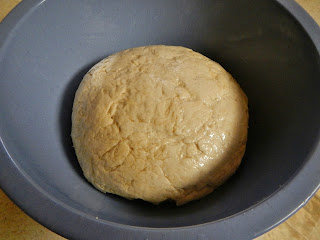In the 1520s, explorers
from Spain introduced wheat to Mexico; as with corn, it made its way up to the
Southwest and into Native fields.
Evidence of trade, between San Juan County Native cultures and Mexico, was
proven with the finding a macaw feather shawl, in Canyonlands National Park, by
explorer, Kent Frost; housed and exhibited at Edge of the Cedar State Park and
Museum. Traces of cacao were found in
pottery at Alkali Ridge National Monument; an exhibit was displayed at the
Natural History Museum in Salt Lake City in 2014.
How did corn and wheat
become the flour to make breads? The
Puebloan people used stone tools; a “mano”, a smooth hand-held stone was used
against a “metate”, a large stone with a depression. The movement of the hand
stone against the depressed stone consisted of a circular, rocking or chopping
motion, using one or both hands, to grind.
Work rooms, called “mealing” rooms, were established with sets of manos
and metates for mass grinding efforts; basically gossip central for the
women. Baking nowadays is much easier
with gas or electric powered ovens; the Puebloans used a mud adobe-built
outdoor oven. The oven was beehive
shaped, using wood as the heat source to build a fire inside. When the proper amount of time had passed,
embers and ashes were removed, or moved about the oven; bread was then inserted
for baking. This oven was also used for
roasting corn and cooking meats. Now
aren’t you happy that all you have to do is head on down to the local
supermarket to buy pre-ground flours and fully baked bread goods?
 Using a recipe from the
“Pueblo Indian Cookbook” by Phyllis Hughes, I ventured into making Pueblo Oven Bread. As a first timer, my bread was not the
prettiest, but it tasted pretty darned good, especially with butter, honey,
combo of both; oh, and bacon. Bacon
makes almost everything better….not desserts though, no not desserts. This first time I also used basic all-purpose
white flour, but I’m going to be playing with other types of flours, like
wheat, blue corn and corn. It will be
interesting to see if baking times vary with the flours, and especially the
tastes. Let me tell you that as a side
for a freshly cooked batch of Anasazi beans with onions and bacon, the bread is
so satisfying. Ah, but that’s another
story to tell…
Using a recipe from the
“Pueblo Indian Cookbook” by Phyllis Hughes, I ventured into making Pueblo Oven Bread. As a first timer, my bread was not the
prettiest, but it tasted pretty darned good, especially with butter, honey,
combo of both; oh, and bacon. Bacon
makes almost everything better….not desserts though, no not desserts. This first time I also used basic all-purpose
white flour, but I’m going to be playing with other types of flours, like
wheat, blue corn and corn. It will be
interesting to see if baking times vary with the flours, and especially the
tastes. Let me tell you that as a side
for a freshly cooked batch of Anasazi beans with onions and bacon, the bread is
so satisfying. Ah, but that’s another
story to tell…
Pueblo Bread
(Pueblo Indian Cookbook –
page 10)
2 packages dry yeast
½ cup warm water (110-120 degrees)
2 tsp. salt
4 Tbsp. melted lard or cooking oil
2 cups water
Preparation:
Soften yeast in warm water. Mix melted lard or oil, salt and yeast in large bowl. Alternately add flour and water, a little at a time. (I did 2 cups flour, ½ cup water), beating thoroughly after each addition, kneading in last of flour until dough is very smooth. Shape in ball and let rise, covered with damp cloth in large greased bowl until doubled in size.
 |
| Activate Yeast |
 |
| Alternate Addition of Flour and Water. |
 |
| Need in Last Cup of Flour. |
 |
| Dough in Bowl for First Rising. |
 |
| Dough Doubles in Size. |
Punch down, and knead on floured board for at least five minutes. Shape into four balls, put in greased baking pans (I used 4-8 inch nonstick cake pans), cover with cloth and let rise for 20-30 minutes in warm place.
 |
| Second Kneading (1) |
 |
| Second Kneading (2) |
 |
| Four Equal Portions |
 |
| Dough Balls in Greased Pans. |
 |
| After Second Rising, Ready to Bake. |
Bake in 400F oven for 50 minutes (my gas oven did require the 50 minutes) or until tops are browned and loaves sound hollow when tapped.
Mary Cokenour



No comments:
Post a Comment